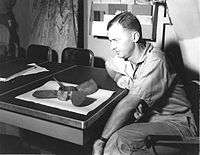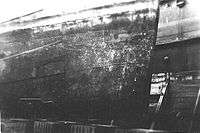_at_anchor.jpg) USS Chaffee DE-230 |
| History |
.svg.png) United States United States |
| Name: |
USS Chaffee |
| Namesake: |
Davis Elliot Chaffee |
| Builder: |
Charleston Navy Yard, SC |
| Launched: |
27 November 1943 |
| Sponsored by: |
Mrs. L. C. Chaffee |
| Commissioned: |
9 May 1944 |
| Decommissioned: |
15 April 1946 |
| Struck: |
29 June 1948 |
Honors and
awards: |
Two battle stars |
| Fate: |
Sold for scrap in 1948 |
| General characteristics |
| Class and type: |
Rudderow |
| Type: |
Destroyer escort |
| Displacement: |
1,450 tons (light) 1,810 tons (full) |
| Length: |
306 feet |
| Beam: |
36 feet, 10 inches |
| Draft: |
9 feet 8 inches |
| Propulsion: |
- General Electric steam turbo-electric drive engine
- Two 3-bladed propellers solid manganese-bronze 8 ft 5 in (2.6 m) diameter
|
| Speed: |
24 knots |
| Range: |
5,500 nautical miles at 15 knots (10,200 km at 28 km/h) |
| Complement: |
186 |
| Armament: |
|
USS Chaffee (DE-230) was a Rudderow-class destroyer escort in the United States Navy during World War II
Chaffee was named for Davis Elliott Chaffee, born in Hartland Township, Ohio, 5 May 1915. He enlisted in the Navy 4 January 1941, was appointed Ensign 6 September 1941, and naval aviator 1 October 1941. While serving with Bomber Squadron 5 based on Yorktown (CV-5), he was killed in action during the Battle of the Coral Sea 8 May 1942. He was posthumously awarded a Navy Cross for his courage in participating in an attack in which an enemy carrier was sunk.
Chaffee was launched 27 November 1943 by Charleston Navy Yard; sponsored by Mrs. L. C. Chaffee; and commissioned 9 May 1944, Lieutenant Commander A. C. Jones, USNR, in command.
After operating on the east coast as a target ship in submarine training, and as a training ship for prospective escort vessel crews, Chaffee cleared Bayonne, New Jersey, 14 October 1944. She arrived at Hollandia, New Guinea on the 21 November for operations in the area screening LSTs, in gunnery and anti-torpedo exercises, and on patrol at the entrance to Aitape.
Chaffee began her role in the battles of the Philippines when she sailed from Hollandia 17 December 1944 to escort landing craft to Leyte. She cleared Hollandia again 8 January 1945 with reinforcements for the recently landed San Fabian Attack Force at Lingayen, where she arrived 21 January. Assigned to patrol in Lingayen Gulf, Chaffee underwent a unique experience on 23 January, when a Japanese Mitsubishi G4M ("Betty") dropped an aerial torpedo which passed through her bow without exploding, or causing any injuries to her crew. (The propeller from the torpedo was recovered in the bow of the ship. It is in the collection of the National Museum of the United States Navy at the Washington Navy Yard, Washington, D.C.) By 2 February, temporary repairs had been completed, and Chaffee returned to patrol duties. She continued to escort convoys in the Philippines, as well as conduct patrols in support of the Mindanao operation until 29 April, when she cleared Parang for Morotai. She returned to the southern Philippines for escort duty 2 May. A week later, she guarded the landing of reinforcements at Davao.
Chaffee arrived at Morotai from the Philippines 19 June 1945 to train for the Borneo operation, and cleared on 28 June to escort reinforcements which landed at Balikpapan 3 July. For the remainder of the war, Chaffee escorted convoys between Morotai and Hollandia and the Philippines. She aided in the establishment of the base in Subic Bay, conducted local patrols and escort missions, and escorted a troop ship to Okinawa in September, then returned to Philippine operations until 10 January 1946, when she cleared Subic Bay for home.
She arrived at San Francisco 5 February, where she was decommissioned 15 April 1946. She was sold 29 June 1948.
Chaffee received two battle stars for World War II service.
| Photos of USS Chaffee During WWII. (Click on images for larger version.) |
|---|
| USS Chaffee at anchor in Subic Bay. |
| Water breaking over the bow of USS Chaffee. |
| View from the bridge of USS Chaffee during the test firing of a torpedo. |
| Temporary repair of the bow of USS Chaffee due to damage from Japanese aerial torpedo. |
| Unidentified officer examining propeller from aerial torpedo that penetrated bow without detonating. |
| Chaffee in dry dock with patch to bow for torpedo damage. |
| View forward from mast of Chaffee showing 5 in. and 40mm guns. |
| View aft from mast of Chaffee showing torpedo tubes, depth charge projectors and racks, and 5 in. and 40mm guns. |
| View along starboard side of Chaffee showing K-gun depth charge projectors and depth charges. |
| Transferring the doctor to another ship via breeches buoy during operations near the Galapagos Islands. |
| An AN (Net Laying Ship) tries to pull USS Chaffee (DE-230) off a reef in the Philippines. |
| USS Chaffee entering an ARD (Auxiliary Repair Drydock) ship for repair after running aground. |
| In dry dock ARD20 at Manicani Island, Philippines after running aground. |
| Damage caused when Chaffee ran aground in San Bernardino Straits can be seen to the port rudder. |
| Sailors working alongside emergency food delivered while aground in Luzon. |
| Damage to Chaffee's starboard screw due to grounding as seen in dry dock. |
| Philippine locals offering their wares to the crew of USS Chaffee while she rested aground for three days off Port Gubat. |
| Submarine Chaser SC-642 ran into a submerged periscope during exercises off New London, CT, causing severe damage to her hull. USS Chaffee came alongside to keep her afloat and towed her to port. |
|
After the war, Chaffee was transferred to the California Maritime Academy (Vallejo, CA), as were some of her sister ships transferred to other maritime academies across the country. Unfortunately, the ship did not have the capabilities to carry an entire class of Merchant Marine midshipmen on a training cruise, nor was the vessel suitable for training officers for the commercial maritime industry. In addition, due to the wear and tear of the war-time environment, the hull would have only been usable as a stationary platform. After stripping some engineering equipment off the ship for use in training students, the hulk was sold and towed away for scrap. The proceeds from the sale of the old DE were used to purchase and build a metal "Butler" building to house a machine shop (with some of the machinery from the ship). This metal ("Butler") building is still in use at the Academy (2004), now as the auto shop for the cadets.
See also
References
_at_anchor.jpg)






.jpg)
.jpg)
_K-guns_and_depth_charges.jpg)
_breeches_buoy.jpg)
_off_a_reef_in_the_Phillipines.jpg)
_entering_dry_dock.jpg)
_in_dry_dock_at_Manicani_Island.jpg)




_towing_SC-642_after_she_hit_a_submerged_periscope..jpg)